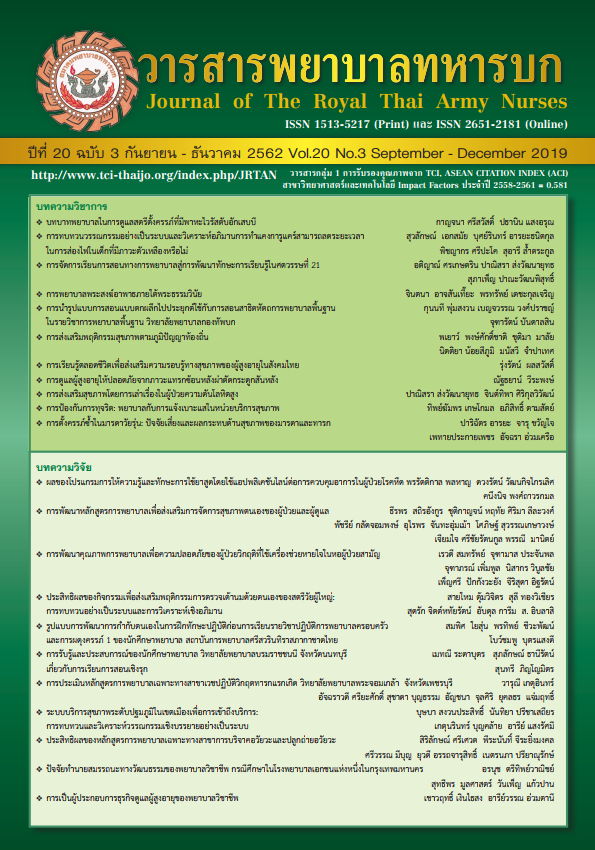Buddhist Monk Illness Nursing Care Follows Dharma Discipline (Tripitaka)
Keywords:
Buddhist Monk illness nursing care, dharma discipline (Tripitaka)Abstract
Buddhist Monk illness nursing care follows the concept of Buddism is a huge of good krama and important thing to do that will affect to caregivers or nurses to have happiness similar to give the nursing care to the Budha. Nursing care following the dharma discipline(Tripitaka) is an important. Buddha’s teaching (Pratham) is the teaching of Budha. The dharma discipline (Tripitaka) was defined by the Buddha that composed of 3 types; Phra Winai Pitaka, Suttatapitaka, and Apithampitaka. Phra Winai pitaka is the Buddha’s teaching related with the discipline of the monks should do for advance celibacy. Suttatapika is the Buddha teaching related the Buddha concept that teach to people in many places. Apithampitaka is the Buddha teaching related the reality of Buddha’s concept following cause and effect of practice. Hence, the nursing care should start with accusation to the monks and say that I wish to care for your request anything from the nurses for necessary need of the monks. For nursing care the nurses should not directly touch to the body. The nurses will touch through the gloves. The problem of nurses in nursing care to the Buddhist monk illness is worry in Dharma discipline that lead to offense of the monks. So if the nurses have the knowledge of the Buddha’discipline they will give the appropriate nursing care for the monks. It will be benefit to the treatment and healing. Then occurring the nursing practice in caring the monk illness following dharma discipline of professional nurses.
Downloads
References
2. Harvey. Introduction to Buddhism, Cambridge University Press, 1990. p3.
3. Office of the Royal Society. Dharma discipline. 3rd edition, Office of the Royal Society. 2009, p.392
4. Sathien Pothinuntha. Tripitaka history.2009. p. 82-83.
5. Office of the Royal Society. Buddha discipline (Pratham). 3rdedition. Office of the Royal Society.2009. p. 454.
6. Faculty of Mahachulalongkornrajavdylaya university. Budhism history. 2009.p. 17-25.
7. Johannes Bronkhorst, Buddhism in the Shadow of Brahmanism Handbook of Oriental Studies (Leiden: Brill).2011. p. 46-47.
8. Huayan doctrine. Encyclopedia of Religion. 2nd edition. Bangkok. 2013.p 41-45.
9. Sumneung Luemsai. Buddha religion. Nonthanuri; Aimpun. 2005. (In Thai).
10. Putharawan Wanthanachaisook. Buddha nirvana. 2017. (In Thai).
11. Phadungyam M, Duvall AC. Rehabilitation Strategies for Resilience Quotient in the Elderly. Journal of The Royal Thai Army Nurses. 2018; 19(1): 66-73. (In Thai).
12. Wonganantnont P, Anuchon S. Information Technology for Aging Society. Journal of The Royal Thai Army Nurses. 2018; 19(3): 27-32.(In Thai).
13. Wongchan W. Metabolic Syndrome in Adult: Self-management. Journal of The Royal Thai Army Nurses. 2018;19 (Supplement MayAugust):16-24. (In Thai).
14. Phornsub Techakuljareon. The nursing practice guideline for the monk illness of the priest hospital. 2017. (In Thai).
Downloads
Published
How to Cite
Issue
Section
License
บทความหรือข้อคิดเห็นใดใดที่ปรากฏในวารสารพยาบาลทหารบกเป็นวรรณกรรมของผู้เขียน ซึ่งบรรณาธิการหรือสมาคมพยาบาลทหารบก ไม่จำเป็นต้องเห็นด้วย
บทความที่ได้รับการตีพิมพ์เป็นลิขสิทธิ์ของวารสารพยาบาลทหารบก
The ideas and opinions expressed in the Journal of The Royal Thai Army Nurses are those of the authors and not necessarily those
of the editor or Royal Thai Army Nurses Association.






